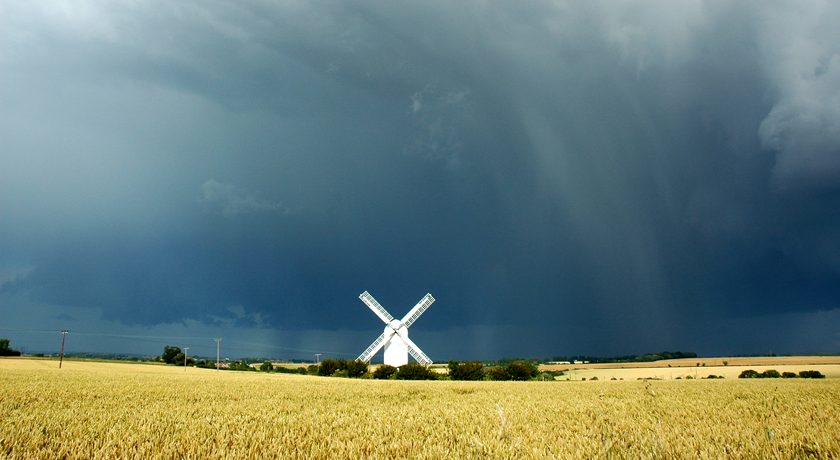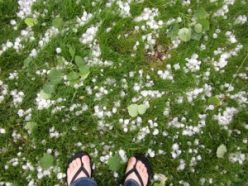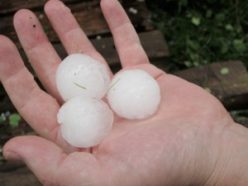Germy weather
Bacteria high in the sky could be causing rain, snow and hail

Thunderstorms that create hail could also be raining bacteria down from the upper atomosphere.

Last June, a hailstorm blasted Bozeman, Mont., sending most people running for cover. Emily Krieger, who edits Science News for Kids, happened to be visiting from Seattle. She watched from a coffee shop as giant balls of hail fell fast from the sky — many of them making small dents in her car.
“It was WICKED!” she says. “It sounded like thousands of baseballs were being thrown — very hard — onto the roof. Car alarms went off, windows shattered, shingles were knocked off roofs.”
The storm brought a lot of damage to the small city. But for Montana State University scientist Alexander Michaud, it also brought an opportunity for science.
Michaud is an ecologist who usually studies life beneath Antarctic glaciers. On that stormy day in June, though, he was more interested in hail. Once it was safe, he ventured outside and collected 27 hailstones for dissection. When another storm hit in July, he collected hundreds more. He cut the hailstones into four layers and studied the water that melted from the stones.
Plenty of scientists had studied hail before, but Michaud was taking a different approach. He was searching for signs of life in the pellets of frozen rain.
“I suddenly realized no one had really ever thought about studying hailstones — in a layered sense — for biology,” he told Science News.
In May, at a meeting of microbiologists, Michaud reported that he found bacteria scattered through the hailstones. Bacteria are tiny organisms made of only one cell, and they can live almost anywhere on Earth (even inside the human body). The cores, or centers, of the stones hosted the most bacteria. The study by Michaud and his colleagues suggests that bacteria may play an important role in the formation of hail.

Precipitation like hail doesn’t just fall from the sky on its own: Hail needs a “seed.” This can be a speck of dust or pollen, for example. Water freezes on the seed, and the icy ball starts to grow. The temperature of the clouds, the air and the earth all help determine what kind of precipitation is formed. As a small ball of ice falls through warmer and then colder parts of a cloud, the ice is alternately melted and refrozen. If it then gets blown upward before falling down, it may form hail.
The giant hail that pummeled Krieger’s car and ended up in Michaud’s lab probably had a wild ride before it landed on earth. Powerful winds may have tossed it up and down through different temperature zones in the sky, and these changes formed the layers of the hail.

Scientists have long suspected that bacteria, like dust, could get blown into the upper atmosphere and become seeds for tiny particles of ice. Researchers have been studying bacteria in the sky since the 1980s, and many researchers argue that bacteria may be involved in the formation of clouds and rain.
More work is needed to know if bacteria can cause hail, said Noah Fierer, a microbiologist at the University of Colorado at Boulder. So far, scientists have found that bacteria can help form ice crystals. This is very different from finding that bacteria actually cause hail, Fierer told Science News. However, he says, finding a large share of bacteria in the center of hail certainly suggests they might cause hail formation.
At the same meeting where Michaud and his colleagues showed the results of their hailstone dissections, other scientists also suggested bacteria play an important role in the climate. A team of French scientists found bacteria in clouds nearly one mile high in the sky.
The French team also identified pollutants that break down in sunlight to form carbon dioxide, which is a greenhouse gas. Some of those pollutants break down only if bacteria are around. That suggests bacteria may help release greenhouse gases. The accumulation of those greenhouses gases is heating up Earth. So, bacteria in the sky may be players in climate change.
These new studies suggest germs help form clouds and hail, and possibly influence climate change. However, “we still don’t know on a global scale how important these processes are,” Anthony Prenni told Science News. Prenni is an atmospheric scientist at Colorado State University in Fort Collins, and he did not work on the new studies.
Prenni said scientists have only recently begun to seriously study the effects of bacteria on clouds. “Within a few years, I think we’re going to have a much better handle on it,” he said.
POWER WORDS (adapted from New Oxford American Dictionary)
hail Pellets of frozen rain that fall in showers from cumulonimbus (anvil-shaped) clouds.
precipitation Rain, snow, sleet or hail that falls to the ground.
bacteria Tiny, single-celled organisms that can live almost anywhere on Earth. Some can cause disease.
atmosphere The envelope of gas that surrounds Earth (or another planet).
greenhouse gas A gas that contributes to the greenhouse effect (the warming of Earth) by absorbing radiation (energy in the form of waves or particles). Carbon dioxide is one example of a greenhouse gas.







